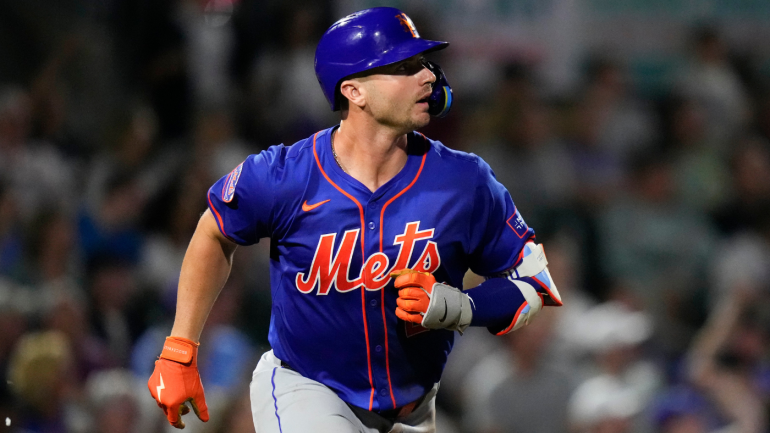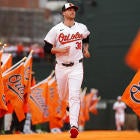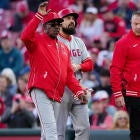
What a difference 12 months can make. A year ago this time, the New York Mets were coming off a 101-win season and a disappointing Wild Card Series loss, which led to an active offseason that saw José Quintana, David Robertson, Kodai Senga, Justin Verlander and others join the team as free agents. The end result was the most expensive roster in MLB history: $374.4 million payroll, plus another $100.8 million in competitive balance tax. Owner Steve Cohen paid close to $500 million for his team.
It was money poorly spent. The Mets went 75-87 in 2023, including a 7-19 June that sunk their season. To their credit, the Mets acted decisively at the trade deadline, and leveraged Cohen's wealth into quality prospects. They ate money to trade Robertson, Verlander, Mark Canha, Max Scherzer, and others, and received better prospects in return. Manager Buck Showalter was let go at the end of the season, and David Stearns, Cohen's white whale, was finally hired as president of baseball operations in October.
"I think the guys who were on the team last year believe that the group that was here last year -- and the group that we have going forward -- is significantly better than what the win total from 2023 would demonstrate," Stearns said on the Foul Territory YouTube show last month. "And I think there are a lot of reasons for that. I think a lot of people in baseball would believe that as well. So I really don't think I have to convince anyone."
Other than their failed pursuit of Yoshinobu Yamamoto -- New York reportedly offered the same 12-year, $325 million contract Yamamoto took from the Los Angeles Dodgers -- the Mets had a relatively low-key offseason. No major free-agent signings, no blockbuster trades, nothing like that. FanGraphs says this is still the most expensive roster in the game at an estimated $328 million, but clearly, this is not an all-in year. Let's preview the upcoming season in Flushing.
Win total projection, odds
- 2023 record: 75-87 (fourth place in NL East)
- 2024 SportsLine win total over/under: 80.5
- World Series odds (via SportsLine): +5000
Projected lineup
- LF Brandon Nimmo, LHB
- RF Starling Marte, RHB
- SS Francisco Lindor, SHB
- 1B Pete Alonso, RHB
- 2B Jeff McNeil, LHB
- C Francisco Alvarez, RHB
- DH D.J. Stewart, LHB
- CF Harrison Bader, RHB
- 3B Brett Baty, LHB
Mark Vientos figures to platoon with Stewart at DH (unless the Mets sign J.D. Martinez) and maybe even challenge Baty, the club's top prospect at this time last year, for playing time at third base. Marte was injured and ineffective much of last year, but he's healthy this spring, and when Marte is healthy, he is a difference-making No. 2 hitter. The lineup flows so much better when Marte is at his best. Alvarez slugged 25 home runs last year, joining Hall of Famer Johnny Bench as the only catchers to hit 25 homers at age 21 or younger. He cemented himself as a long-term building block. Baty and Vientos will look to do the same in 2024.
Projected rotation
- LHP José Quintana
- RHP Luis Severino
- LHP Sean Manaea
- RHP Adrian Houser
- RHP Tylor Megill
Senga, the NL Rookie of the Year runner-up and presumed Opening Day starter, will begin the season on the injured list with a shoulder injury. That clears the way for Megill to make the rotation. Severino will look to bounce back from a terrible 2023 campaign with the crosstown New York Yankees while Manaea tries to build on the adjustments he made last year. Houser, Manaea (opt out), Quintana, and Severino can all become free agents after the season. If the Mets are out of the race again, they could be a pitching clearinghouse at the trade deadline, when prospects like Dominic Hamel, Christian Scott, and Mike Vasil could be ready to step in. David Peterson is recovering from hip surgery and should be back at midseason.
Projected bullpen
- Closer: RHP Edwin Díaz
- Setup: RHP Adam Ottavino, LHP Brooks Raley
- Middle: LHP Jake Diekman, RHP Jorge López, RHP Shintaro Fujinami, RHP Drew Smith
- Long: RHP Phil Bickford
Things started to go downhill for the Mets in spring training when Díaz suffered a season-ending injury to his knee in the World Baseball Classic, and while the 2023 Mets were not a lockdown closer away from contention, it certainly created bad vibes before the year even began. Setting up Díaz will be a series of veteran power arms who don't always know where the ball is going, especially Fujinami. One thing the Mets lack in the bullpen is flexibility. Fujinami is the only reliever who can be optioned to the minors, meaning shuttling fresh arms in and out could be a challenge at times.
How will Alonso's contract year play out?
Unless the Mets emerge as a postseason contender -- which is certainly possible, though I wouldn't call it the expected outcome at this point -- Alonso's upcoming free agency will loom over the Mets all season. He has said he wants to remain a Met long-term, but the two sides have gained no traction during extension talks, and Stearns recently acknowledged Alonso becoming a free agent after the season is the most likely outcome.
"Right now, I feel really blessed that I get to be a part of this 2024 squad. I think we have a really good team. I'm super excited to get this spring training underway. We have a great group. I'm really excited. I'm really excited to be here," Alonso said after reporting to spring training (per SNY). "And playing in an iconic city like New York, I mean, it's really a blessing. It's a great place to play. The fans are awesome. I love it. Again, I'm just really blessed to be here."
There are good reasons to extend Alonso and good reasons not to extend Alonso. He's a fan favorite and clearly loves being a Met, which counts for something, but also the aging curve for right/right first basemen is harsh. Those guys tend to be poor investments in their 30s, and Alonso will be 30 on Opening Day 2025. Would Stearns trade Alonso at the deadline if the Mets are out of the race? More accurately, would Cohen allow Stearns to trade Alonso if the Mets are out of the race?
The Mets discussed an Alonso deal at last year's deadline, most notably with the Chicago Cubs and Milwaukee Brewers, but discussing a trade and executing a trade are very different things. Then again, Alonso is a Scott Boras client, and Boras is known to drive a very hard bargain. Come midseason, it could be that Boras and the Mets are so far apart on an extension that a trade is the only logical choice, especially if the Mets are not in the thick of the postseason race.
Because of their competitive balance tax status, the Mets will only receive a compensation draft pick after the fourth round if Alonso leaves as a free agent. Rental first base bats usually don't fetch a ton at the deadline, but whatever the Mets get at the deadline figures to beat a measly fourth-round pick. With an extension unlikely, Alonso will be talked about as a trade candidate right up until the deadline. The Mets will likely have to win a free-agent bidding war next winter to retain him long-term.
Will any young players emerge as cornerstones?
As noted, Alvarez joined Bench last season as the only catchers to hit 25 homers at age 21 or younger. His brand of power is rare behind the plate, and his defense was better than expected too. Alvarez's rookie season was an unqualified success. For Baty though, 2023 only created questions about his long-term place in the organization. He slashed .212/.275/.323 with nine homers in 108 games and put the ball on the ground way, way too much. It was a golden opportunity and Baty fumbled it.
Dynamic infielder Ronny Mauricio tore his ACL in winter ball and will miss a big chunk of the season, so Baty will again get another opportunity at third base (Joey Wendle is the backup). Baty will play the entire season at age 24, so he's still very young, though this does feel like a big season for the young man. He'll have another opportunity to show he's the long-term answer at third base, and if he's unable to break through and live up to his prospect pedigree, he might not get another opportunity in 2025.
Hamel, Scott, and Vasil could all get a look in the rotation at some point -- Scott is the best prospect of the bunch but Hamel is closest to MLB -- and Jett Williams, one of the club's top prospects, is rising fast. Williams is a natural shortstop, though Lindor isn't going anywhere, so he'll see time in center field this summer. Infielder Luisangel Acuña (Scherzer trade) and outfielder Drew Gilbert (Verlander trade) came over at last year's deadline and could arrive this year. (Luisangel is Ronald's younger brother.)
It is something of an open secret that the Mets are treating 2024 as a transition year. Do they want to win games and compete for a postseason spot? Yes, of course, but the priority is development and putting the team in the best position to succeed in 2025 and beyond. That the Mets didn't splurge for, say, Matt Chapman when Mauricio got hurt or Jordan Montgomery or Blake Snell when Senga got hurt tells you the priority is not 2024. Opportunities will be there for young players. It's up to them to capitalize.
What would make for a successful season?
Well, there are three wild-card spots, right? Figure one will go to the Atlanta Braves or Philadelphia Phillies, whichever one doesn't win the NL East. At that point the Mets will need to beat out the second-place team in either the NL Central and NL West to get a postseason spot. Is that doable? I think so. Is it likely? No, probably not, but it's doable. The priority is development, and playing meaningful games in a competitive race aids development too.
Realistically, competing for a postseason spot would be a cherry on top. For the Mets, success in 2024 will be defined by their young players. Does Baty break out? Does Megill finally grab a full-time rotation spot? Does someone like Acuña or Gilbert or Scott or Williams rocket up and arrive at some point? The Mets are running out the clock on some large contracts this season (Scherzer, Verlander, James McCann). They want to use that freed up money to supplement a new young core in 2025, not prop up a leaky foundation.






















